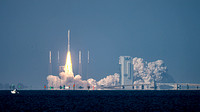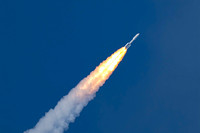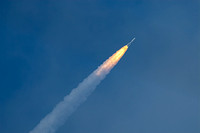Created 27-Mar-20
Modified 13-Dec-23
Excerpts from Spaceflightnow.com:
The sixth and final satellite in the U.S. military’s most secure satellite communications fleet lifted off from Cape Canaveral Thursday aboard a United Launch Alliance Atlas 5 rocket, extending the network’s expected lifetime beyond 2030.
The 197-foot-tall (60-meter) Atlas 5 rocket fired off pad 41 at Cape Canaveral Air Force Station at 4:18 p.m. EDT (2018 GMT) Thursday. The fiery start to the mission was delayed more than an hour for ULA teams to troubleshoot a problem with a ground hydraulics controller, which triggered a last-minute hold in the day’s first countdown.
The technical concern was cleared before the end of Thursday’s two-hour launch window, and the countdown resumed for another launch attempt. At T-minus 2.7 seconds, the rocket’s kerosene-fueled RD-180 engine flashed to life, followed seconds later by ignition of five strap-on solid rocket boosters.
The Atlas 5 climbed away from the launch pad with some 2.6 million pounds of thrust, turning east over the Atlantic Ocean with the U.S. military’s sixth Advanced Extremely High Frequency communications satellite.
The launcher’s boosters — made by Aerojet Rocketdyne — burned out and jettisoned less than two minutes after liftoff, followed by separation of the Atlas 5’s Swiss-made payload fairing. Four-and-a-half minutes into the mission, the Atlas 5’s first stage Russian-built main engine shut down, and stage separation occurred seconds later.
Photos taken from SR 528 - a distance of about 13 miles.
© Dennis Huff








